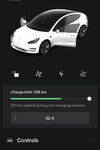I would like to see the part of the manual stating that the car do not want to stay low in SOC for long time. My guess is that the car manufacturer encourages the car owner to charge at low SOC for the exact same reason that the gas meter is red colored in the low reserve part and there might also be a red lamp on.
Tesla colors the battery amber/yellow > 20% and red below 10%. When parking there is a note comming up on the screen about something like this:
“Weak battery” “Plan your next charge”
Many people takes this as a sign of that the battery will get damaged from low SOC.
The 12v lead acid battery is sensitive to getting discharged but this should only happen after the big battery disconnects due to low SOC. Thos is described below.
View attachment 796739
View attachment 796740
Tesla have no information about low SOC should be bad for the LiB. Theres is information which people have interpreted as “because its bad for the battery” but if you look carefully there is no information saying this, only text that wrongly can be read out of the context and then our minds fill in the blank parts with imagined parts that is not correct.
There is research for most battery types, including Samsung SDI NMC. From what I have seen, there really is not a noticable difference and these behave as expected For cells with NMC-chemistry.
https://arxiv.org/pdf/2007.01937.pdf
I fail to find
any information in the article in the link about low SOC being bad. I also ca not find any information about minimum cell stress being in the middle. You need to point out the exact text that include those statements.
As I did write yesterday, we
need to understand that there is a big difference between overdischarge batteries that is discharge below the low volt limit set by the manufacturers. For most lithium ion batteries 2.5 to 4.20 V/cell is the allowed range.
0% SOC is when reaching the minimum voltage during discharge.
All research (litterally all) show us that the lower the SOC, within the specified allowed voltage range, the lower the calendar aging.
There is not really any exceptions.



